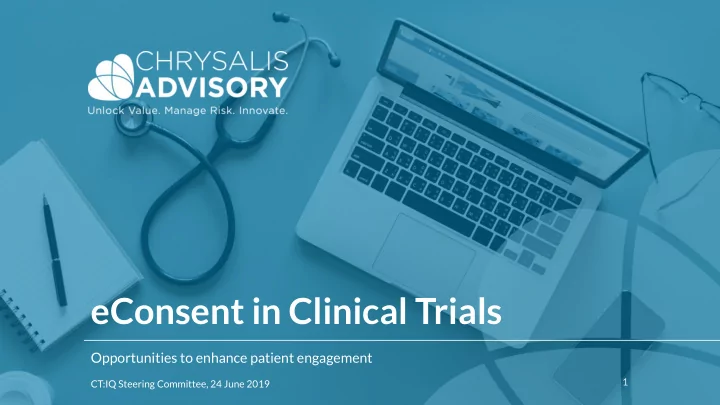

eConsent in Clinical Trials Opportunities to enhance patient engagement 1 CT:IQ Steering Committee, 24 June 2019
Agenda 01 | Project scope 02 | Methodology 03 | Background & context 04 | Use cases 05 | Benefits 06 | Barriers to uptake 07 | Pathways forward - critical success factors 2
1. Scope 3
2. Methodology Semi-structured interviews with 19 stakeholders ● Survey questionnaire, n = 179 ● 4
3. Background & context What exactly do we mean by eInformation and eConsent? 5
How much exposure to eConsent have people had? 6
7
4. Use Cases eConsent with a physical eConsent using cloud-based 1 3 signature software eConsent on a supplied device eConsent using biometric 2 4 information 8
9
Current usage of eConsent/Patient Registration A cluster randomised, crossover, non-inferiority trial of aspirin compared to low molecular weight heparin for venous thromboembolism prophylaxis and safety in hip or knee arthroplasty, a registry nested study -CRISTAL (ACTRN12618001879257) Prof Ian Harris- UNSW Consent is to the data collection ● Pragmatic design of SOC options ● Patients can register either through a URL or an iPad ● Questionnaires delivered through URL, iPad or through telephone interview. ● 10
11
12
13
14
CALD 15
Regional and Rural patients ● Teletrials still not widespread and won’t be achievable for all studies ● Patients will require stays in metropolitan centres ● Eligibility screening and consent can be done remotely ○ Pre-reading may reduce time needed to go through the consent process- which may reduce the stay away from home ○ New information can be shared more easily 16
5. Benefits 17
What wasn’t seen as a significant benefit? 18
6. Barriers to uptake 19
What wasn’t seen as a significant barrier to uptake? 20
7. Pathways forward - critical success factors 21
7. Pathways forward - critical success factors 22
Open Forum Questions 1. What questions do people have? 2. Where to from here? 3. How might CT:IQ help to catalyze change and support adoption of eConsent? 23
Thank you. Nick Northcott Nik Zeps Partner Expert Advisor BSc, BCom, MBA, GAICD BSc, PhD t +61 2 9188 4080 | m +61 417 610 557 e nick@chrysalisadvisory.com.au | w chrysalisadvisory.com.au 24
Recommend
More recommend